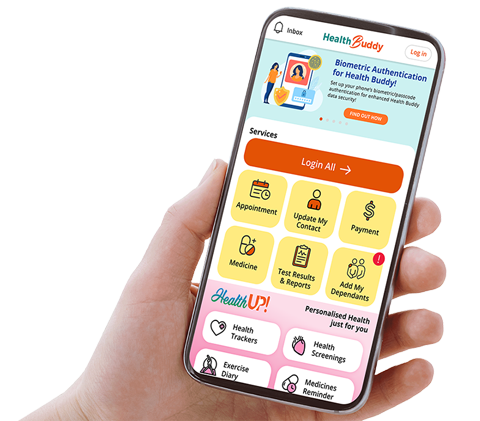Changi General Hospital will NEVER ask you to transfer money over a call. If in doubt, call the 24/7 ScamShield helpline at 1799, or visit the ScamShield website at www.scamshield.gov.sg.
Magnetic Resonance Imaging (MRI)

What is MRI?
Magnetic Resonance Imaging (MRI) is a medical imaging technique that uses strong magnetic fields and radio waves to produce detailed images of the body. Able to distinguish between fat, muscle, water, and other soft tissues, MRI is commonly used to image body parts such as the brain, spine, heart, liver, prostate, and other skeletal structures.
MRI is useful for diagnosing diseases and monitoring lesions in organs. This reduces the need for invasive methods such as biopsies or exploratory procedures.
Lying on a bed, patients enter a tunnel-shaped opening in the machine for the scan. Patients with claustrophobia may be unable to tolerate the scan and can opt to be sedated.
Some MRI scans may require gadolinium contrast (a type of dye) to be injected into the veins to highlight certain structures.
Is MRI Safe?
MRI scans do not use radiation, unlike X-rays or CT scans. However, as there is a strong magnetic field, objects that are ferromagnetic (contain iron/ cobalt/ nickel) cannot enter the scan room. As a safety precaution, detailed screening will be carried out by the radiographer prior to the scan to detect for any ferromagnetic items on the patient.
Although there is no evidence to suggest that MRI poses a risk during pregnancy, please inform your
doctor and radiographer if you are pregnant, or suspect that you may be pregnant, before your MRI scan. Women in their first trimester are usually not recommended to undergo an MRI scan. Additionally, contrast dye should not be given to pregnant women.
MRI scan contrast dye must be used with caution in patients who are allergic to the contrast dye or have kidney failure. Safety protocols are put in place to assess the patient’s suitability and the appropriate imaging type for the patient.
Examples of MRI Scans
- Liver MRIs can be used to diagnose tumours for patients with Hepatitis B
- Spine MRIs can be used to check for slipped discs or pinching of the nerves that cause back pain
- Knee MRIs can be used to check for soft tissue and ligamental injury
- Brain MRIs can be used to diagnose stroke, dementia, and tumours
Brochures
![]() Magnetic Resonance Imaging (MRI) [ 1.26 MB | PDF ]
Magnetic Resonance Imaging (MRI) [ 1.26 MB | PDF ]
Videos
View this video with subtitles in other languages: Mandarin | Malay | Tamil
Contact Information
Changi General Hospital, Main Building, Level B1, Radiology Department
Changi General Hospital, Integrated Building, Level 3, Diagnostic Centre
For new appointments:
(65) 6850 4843
To reschedule appointments: (65) 6789 8883
Stay Healthy With
© 2025 SingHealth Group. All Rights Reserved.


















